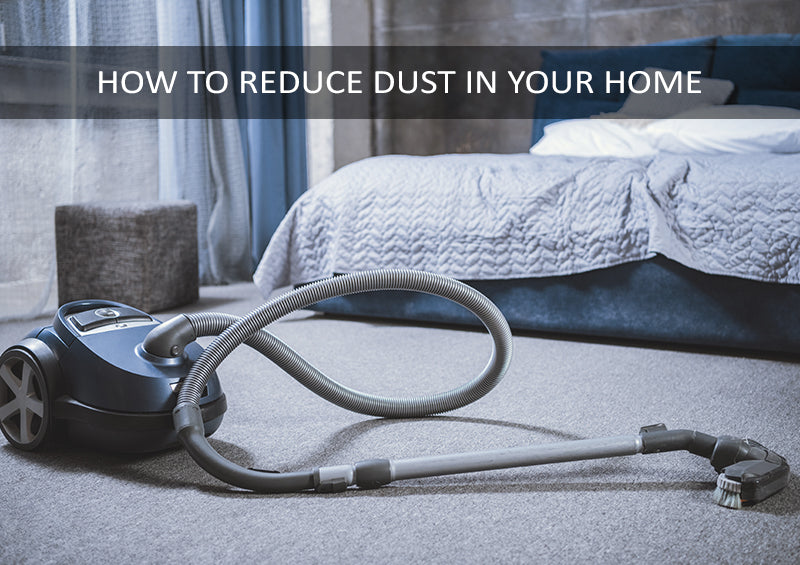In this guide you will find the simple ways to remove the dust from your home. It can be hazardous to health and cause some irritating symptoms, not to mention the detrimental affect it can have on sleep.
It is important to keep on top of this re-occurring nuisance in your home, and it’s a lot easier than you might think.
From the biggest cleaning myths (stay away from feather dusters) to clever storage hacks, this guide has everything you need for a dust free home.
Also find the answers to questions such as ‘where does it come from?’ ‘do I have dust mites?’ and ‘how does it affect sleep?’.
But first, lets start with the tips to remove it from your home…
How to get rid of dust in your house
From simple everyday changes to clever investments, there are plenty of ways to reduce the amount of dust in your home. Here are our tried and tested top tips…
Wash your bed sheets once a week
Falling into a lovely bed of dust after a hard day at work, we know that’s not what you want.
But, if you only washing your bedding once in a blue moon, it’s most likely the reality. Did you know a third of the weight of your pillow could be made up of dead skin and dust mites?
It pains us to tell you, but it’s true.
Bed sheets can be the number one source for collecting and housing a whole load of dust related nasties, so make sure washing them once a week is a top priority. Also, use hot water when washing as cold may not kill the dust mites.
Don’t forget to clean your mattress
No, I’m not recommending stuffing your 6-foot mattress into the washing machine. I’m not even recommending hiring an expensive professional cleaner to do the job.
There’s a much simpler way to eliminate the creepy crawlies from your beloved mattress.
Baking soda, oil, a vacuum and a bit of elbow grease.
Add a few drops of your favourite essential oil into some baking soda to really freshen things up. Sprinkle the mixture over your mattress and allow to sit for around 15 minutes.
Vacuum up the remains to suck out the dust mites. Bear in mind that this only works for fabric mattresses and wouldn’t work on latex. For even more cleanliness, use a vacuum cleaner that has a HEPA filter to remove every last bit of dirt.
Get into a routine of vacuuming and mopping the floors
Whilst you’ve got the vac out, don’t forget to use it on the floors.
This is especially important for carpeted floors, which is a bacteria breading playground for dust mites. Those hundreds of thousands of tiny fibres? The mites love getting deeply nestled in those.
We can’t give up, we’ve got to fight these mites.
Vacuuming at least once a week (everyday would be ideal, but who has time for that) will greatly reduce the amount of dust in your home.
And don’t forget to follow that up with some good old mopping. This is to collect any residue the hoover didn’t collect. (I’m talking about wooden or tiled flooring, please don’t mop your carpet).
Understand the importance of doormats
Doormats may hold more importance than you realise. Yes, they’re nice decoration and they make sure guests feel welcome with a subtle ‘WELCOME’ message, but they do so much more than that.
If you don’t want to ask guests to remove their shoes at the door, a mat is essential.
Most of inside dust comes from outside. There are many ways this happens, open windows, clothing, open doors etc.
However, wearing shoes in the house is the biggest factor.
All that outside dirt gets trailed through the house and eventually dries up into dust. Asking guests to remove shoes can be a little awkward, so make sure you have a mat to remove excess dirt as soon as they set foot into your home.
You might also want to consider changing ‘WELCOME’ to ‘WIPE’.
Use a damp cloth and ditch your duster
We’ve been lied to.
A duster doesn’t remove dust, it spreads it.
I mean yes, it is fun prancing round the house and gently dusting random surfaces, feeling like you’re doing lots of cleaning with minimal effort. I’m afraid to say that it’s all a façade.
They don’t retain all the dust and just end up scattering it across the room as your cleaning.
To ensure you’re picking up all the dirt, use a damp cloth and rinse between wipes. Microfibre cloths are particularly useful as they do a great job of clinging onto the tiny particles.
Invest in a dehumidifier or air purifier
Both of these devices are a smart investment for keeping the dust levels under control in your home.
The primary purpose of an air purifier is to clean the air. It removes contaminants, which could be mites, dust, smoke, dirt or any other allergens. They are great for those who suffer with allergies as they reduce symptoms being triggered.
A dehumidifier can also help reduce the amount of dust in your home. Although its main purpose is to remove excess moisture from the air, the reduction in humidity contributes to lessening the dust mites, mould and mildew.
Beat cushions and rugs regularly
Bad week at work? Take it out on your cushions and rugs (relieve anger and clean at the same time!)
Make sure to remove covers so you don’t damage them and beat the living daylights out of them. Its therapeutic and a way to get all the deep-rooted dust out of there.
Just make sure you do it outside, as doing this inside will simply spread the dirt throughout the room and allow it to find somewhere else to settle.
If cushions are attached to furniture, take them outside too if you can.
Brush your pets regularly in a designated area
Pets… cute, fluffy and full of dust.
Do you have a dog that loves rolling around on the floor? Or a cat that spends most of its time outside? I’m shuddering at the thought of all that dirt.
Answer? Get rid of all your pets.
I’m joking, of course! Just get started on a weekly brushing routine. Instead of the fur and dirt being evenly dispersed across your whole house, take control and brush it all out once a week so you can easily dispose of it.
Just make sure to do it on a wooden or tiled flooring or something that can easily be cleaned.
Put your unwanted clothes in storage
Is your wardrobe full of clothes you don’t really wear but don’t want to throw away? You’re not alone.
In fact, most people don’t wear around 50% of their wardrobe. And, you know what kind of surfaces collect dust?
You can see where I’m going here.
Clothes are huge dirt collectors; all those soft fabrics just love to cling on to every last dust particle. Store away your unworn clothes in plastic boxes or bags so they remain nice and clean, which will help keep your room more clean and fresh.
Use a lint roller for the clothes you do wear
For the clothes you do want to keep in your wardrobe, rely on your trusty companion, the lint roller.
‘What on Earth is a lint roller?’ I hear you ask. It is an American term, so you may not be familiar with this life changing contraption.
It is simply a handheld device that has a sticky roll on the end of it. All you need to do is roll it across a surface and it collects dust, dirt or any other debris. It’s quick, simple and easy.
If you see dust collecting on the clothes in your wardrobe, use a lint roller once a week to keep on top of it.
Now you’ve got the best tips for keeping your home clean, here’s a little more insight into what dust is and how it affects us…
Where does dust come from?
Although it may seem like, dust doesn’t just magically appear out of thin air. It’s a collection of so many different things, some of which include:
- Pollen
- Human hair
- Animal hair or fur
- Textile fibres
- Paper fibres
- Bacteria
- Insects
- Insulation
- Soil
- Dust mites and their droppings
- Dead skin cells
Sorry if that gross list made you feel a little itchy.
Most dust comes from outside, as it can be attached to shoes, clothes, bags, your pets or come in through the window. Some rooms are susceptible to it than other, which may explain why you get more in the bedroom or living room.
It clings to soft furnishings or material that have fibres. Its also known for settling on electronic devices such as TVs or gaming stations.
So, you know where it comes from, but do you need to look out for mites? Keep reading to find out how to spot them in your home…
How do you know if you have dust mites?
This is a common question as most people don’t realise they have a dust mite infestation. This is easily done as mites are microscopic, which means they can’t be seen by the naked eye.
So, how are you supposed to find out if you have them? Well, there are a couple simple ways.
Firstly, you can buy a cheap microscope and investigate for yourself. Collect samples by picking up dust with pieces of clear Sellotape. Stick them under the microscope and look out for any mites or their droppings which look like little round pellets.
Another option is to use a professional dust mite testing kit. There are ones available that give you results at home or some may have to be sent off to a lab.
It is important to know that these mites aren’t harmless as they could have a detrimental effect on your sleep…
Can dust mites affect your sleep?
These pesky mites don’t just pose a threat for allergy sufferers, but they can also have an affect on those who aren’t allergic.
If you’re not sure whether you’re allergic, here are some symptoms to look out for:
- Runny or blocked nose
- Sneezing
- Sore, red or watery eyes
- Cough or sore throat
- Facial pains or aches
- Blocked sinuses
Of course, all of these symptoms will have a detrimental effect on your sleep. A flare up in allergy symptoms can reduce the quality and quantity of your sleep, which could even emphasise your symptoms.
Even if you aren’t allergic, a build up of dust may trigger some symptoms such as a runny nose or sneezing.
At Siesta in Style, we care about your sleep. From the calming ways to relax in the evening to recommending the best bedding products, you can find fantastic advice on our sleep blog.
If there’s a topic you’d like us to cover, leave a comment below and we can give you some expert advice.
 Free Shipping
Free Shipping
 +44(0)1204 529156
+44(0)1204 529156
 m.ahmad@swliving.co.uk
m.ahmad@swliving.co.uk

